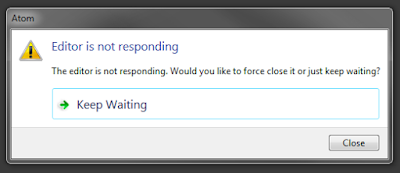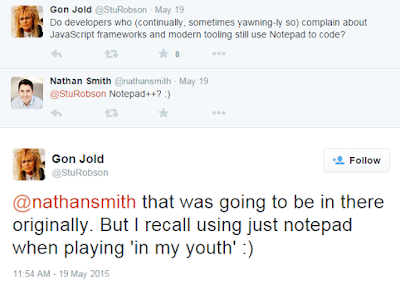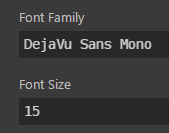Sunday, October 2, 2016
Atom shows promise
Atom shows promise
Update: My efforts have switched to Brackets, another open source text editor that is much faster. I recommend this font fix, the Tomorrow Night theme, and the following extensions:
- Autobabel
- Brackets Beautify
- Brackets Snippets (by edc)
- Brackets TSLint
- Brackets TypeScript
- brackets-eslint
- Brackets-Gulp
- CloseAllOpenFiles
- CSSLint
- Open project in terminal
- Proper Indent
- Tabs - Custom Working
_______________________________
This article assumes you dont hate JavaScript. Lets face it, JavaScript in some form or fashion is here to stay.
If you want to be a JavaScript/HTML5/Hybrid/Node developer, youll need to pick an editor/IDE. Although heavyweight options exist (Eclipse, NetBeans, Visual Studio, etc), most agile developers prefer a more nimble tool, like Sublime Text, Komodo IDE, or WebStorm. A relative newcomer to the crowd is Atom from GitHub (the company).
Unlike many tools in this genre, Atom is free. In addition, it is cross-platform and there are lots of plugin packages and themes that allow you to extensively customize it. That said, at times it can be woefully slow, even on a powerful 8 core/8 GB memory laptop:

That said, the brilliant engineers at GitHub and the passionate Atom community continue to make improvements and I anticipate the experience will only improve with time.
If youre not ready to shell out hard cash for another tool or youd prefer to support Open Source, here are a few steps that worked well for me:
1. Install Git
2. Install Node 4 (this incorporates many improvements from the io.js fork)
3. Install Atom
At this point, you could theoretically create a Hello World! app, but in reality youre going to need a ton more tools and libraries. Thats because the good ol days of creating websites in Notepad are long gone.

This reality has some drawbacks as a barrier to entry for new or casual developers:

Theres another hidden downside: performance. Even cutting-edge frameworks and toolsets suffer from the inherent modularity of Node:


node-gyp alone adds an appalling 8+ GB to your setup process. The idea that I have to install Visual Studio Express and an old version of Python just to have a compiler for Node to work is ridiculous. And the bad news just gets worse.
There are many, many hacks you could apply to bandage over this reality but it will eventually dawn on you that you need an OS from a Unix/Linux pedigree to be a truly effective developer.
Okay, enough of the rant tangent. Lets get back to Atom!
Assuming youre still reading this lengthy post (congrats!), here are a few configuration tips:
1. First, youll want to install some useful global Node packages. Open a terminal/command prompt and enter:
npm install -g babel babel-core babel-eslint babelify eslint gulp gulp-less jspm less napa node-gyp yo
2. Now, youll want to install some useful Atom packages:
apm install atom-terminal atom-typescript cssfmt gulp-watcher es-identifier-highlight jsfmt language-babel linter linter-eslint linter-stylelint linter-tslint project-jump project-view turbo-javascript
3. You can also optionally install an Atom theme. I personally like Outlander:
apm install outlander-syntax outlander-ui file-type-icons
5. Now, open Atom, go to File > Settings and set the desired font family and increase the font size to 15 (your eyes will thank me a decade from now)

P.S. While youre in this screen, feel free to set your Project Home to match your GitHub Desktop projects location.
6. Next, click on Themes in the left-column menu and set your desired theme:

7. Finally, youll want to set a keyboard shortcut for opening projects.
Note: If youre having issues with creating a custom ESLint ruleset, check out https://github.com/AtomLinter/linter-stylelint/issues/10
~~~~~~
There you have it! A powerful, free code editor that looks and acts like all the other cool kids screens at tech conferences :)
Available link for download